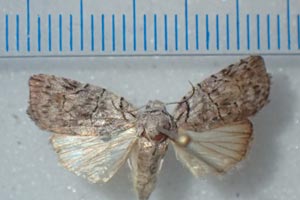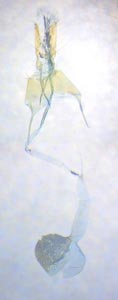

 +9Kontinente:EUAF
+9Kontinente:EUAF3. Biologie
3.1. Nahrung der Raupe
- [Verbenaceae:]Lantana camara Wandelröschen)
- [Fabaceae:] Vachellia tortilis [= Acacia tortilis] (Schirm-Akazie)
- [Fabaceae:] Vachellia xanthophloea [= Acacia xanthophloea] (Gelbrinden-Akazie, Fieber-Akazie)
- [Fabaceae:] Cajanus cajan (Straucherbse)
- [Malvaceae:]Abelmoschus esculentus ? (Okra ?)
Bippus (2019: 308) berichtet: "This species is also rather common in Reunion, where the author reared it from Lantana camara L. (Verbanaceae), 18.x.2015, collected in La Possession, alt. 500m. In Kenya this species also was recorded on Acacia xanthophloea Benth. and Acacia tortilis (Forssk.) Hayne (Fabaceae) by Agassiz & Harper (2009). Hostplants: Acacia xanthophloea Benth., Acacia tortilis (Forssk.) Hayne (Fabaceae) and Lantana camara L. (Verbanaceae)." Die Angaben zu den beiden Akazien betreffen dabei nach Agassiz & Harper (2009: 7) nur wenige Raupen "on flowers and leaves".
Agassiz et al. (2013: 124) schreiben zu England: "Occasionally imported on peas and okra. Ob es sich dabei auch um die Raupennahrungspflanzen handelte, wird nicht gesagt, insgesamt spricht hier aber Vieles dafür, die Art als polyphag anzusehen. Honey & Sterling (1994: 33) hatten erläutert: "There is little published information on the natural foodplants of this species but there are specimens in the Natural History Museum collections reared from pigeon pea, Cajanus cajan (L.) (Leguminosae), and Lantana, Lantana camara (L.) (Verbenaceae). Larvae have also been previously imported into Britain on okra, Abelmoschus escultentus (L.) (Malvaceae) from Cyprus and on peas from East Africa."
4. Weitere Informationen
4.1. Andere Kombinationen
- Sarrothripa virgulana Mabille, 1880 [Originalkombination]
4.2. Synonyme
- Giaura nigriscripta Hampson, 1905
4.3. Faunistik
P. virgulana ist in Europa sicher (noch) nicht etabliert. Agassiz et al. (2013: 124) führen die Art bei den "adventive species" und schreiben zu England: "Occasionally imported on peas and okra. Also one Thorpe-le-Soken, Essex, 1992. Mediterranean/ African." Auf der Artseite von [Hantsmoths.org.uk] wird erläutert: "Recorded infrequently through accidental importation in okra from Africa, recorded for the first time in Britain at Thorpe-le-Soken, Essex in September 1992, with no further records to date. Not recorded in Hampshire or on the Isle of Wight to date. Wingspan 23-29 mm. Main confusion species is Oak Nycteoline Nycteola revayana, but forewing broader and leading edge curved, not concave. Larva feeds on Okra and Leguminosae, causing sufficient damage to be a serious pest in some areas; no evidence of breeding in the UK." Waren die früheren Funde alle direkt an den Handelswaren gefunden worden, fiel der Falterfund im September 1992 aus der Reihe. berichteten: "On 27.ix. 1992 Mark Sterling joined John Phillips and David Young on a trip to search for Gortyna borelii lunata (Frey.) at a site on the edge of Hamford Water near Thorpe le Soken in Essex. A number of lights were run at the site, including a 15-watt actinic, which attracted a small noctuid which was initially misidentified as Nycteola revayana (Scop.). On closer inspection it had several unusual features, including bright white hind wings and hind legs. The specimen was therefore taken to the Natural History Museum where it was determined by Martin Honey as a female Pardasena virgulana (Mabille). [...] The species is listed by Hampson (1912: 245) and Gaede (1935: 181) as occurring in South and East Africa and Madagascar but there are specimens in the Natural History Museum collection from most tropical and non-tropical areas of Africa, including North Africa and certain Middle Eastern States, Cameroun, Comoro Islands, Ethiopia, Ivory Coast, Kenya, Madagascar, Malawi, Mauritius, Mozambique, Nigeria, Saudi Arabia, Sierra Leone, South Africa, Southern Yemen, Tanzania, Uganda, Zambia and Zimbabwe. [...] Larvae have also been previously imported into Britain on okra, Abelmoschus escultentus (L.) (Malvaceae) from Cyprus and on peas from East Africa. The latter were successfully reared at the M.A.F.F. laboratories at Harpenden. With the proximity of the collecting site to both Felixstowe and Harwich the most likely explanation for its occurrence in Britain is as a vagrant imported on a ship."
Die Art wurde von Madagaskar beschrieben; Bippus (2019: 308) fand sie dort auch aktuell, außerdem als Raupe auf Réunion. Er schreibt: "Distribution: southern and eastern Africa, including Madagascar, Mauritius and Reunion." Agassiz & Harper (2009) hatten die Art als Raupe in Kenia gefunden. Hacker (2019: 434-435) melden Falter von "Eastern Cape, Asante Sana" in Südafrika und vermerken: "Distribution: "evidently widespread in Subsaharan Africa, especially in its eastern and southern parts. Also recorded from Madacascar (Viette 1990)." Auf der Artseite von [afromoths.net] werden Falter von Tansania, Zimbabwe, Réunion und Sierra Leone gezeigt.
(Autor: Erwin Rennwald)
4.4. Literatur
- Agassiz, D.J.L., Beavan, S.D. & R.J. Heckford (2013): Checklist of the Lepidoptera of the British Isles. - Royal Entomological Society. 206pp.
- Agassiz, D.J.L. & D.M. Harper (2009): The Macrolepidoptera fauna of Acacia in the Kenyan Rift Valley (Part 1). — Tropical Lepidoptera Research, 19 (1): 4-8. [PDF auf troplep.org]
- Bippus, M. (2019): On some Nolidae (Lepidoptera) of the islands of the Western Indian Ocean. — Entomofauna, 40/2 (13): 305-313. [PDF auf zobodat.at]
- Hacker, H.H. (2019): Families Nolidae Bruand 1846, Erebidae Leach, 1815, Euteliidae Grote, 1882 and Noctuidae Latreille, (Noctuoidea). — pp. 429-537. In: Mey W. & M. Krüger [Eds.] (2019): The Lepidoptera fauna of a crater valley in the Great Escarpment of South Africa: The Asante Sana Project. — Esperiana Memoir 8: 1-551.
- Honey, M.R. & M. Sterling (1994): Pardasena virgulana (Mabille) (Lepidoptera: Noctuidae), a species not previously found in the wild in Britain. — British Journal of Entomology and Natural History, 7(2): 33-34. [Digitalisat auf biodiversitylibrary.org]
- Erstbeschreibung: Mabille, P. (1880): Comptes Rendus. Diagnoses Lepidopterorum Malgassicorum. — Bulletin de la Société entomologique de Belgique 23: xvi–xxvii. [Sekundärzitat]












